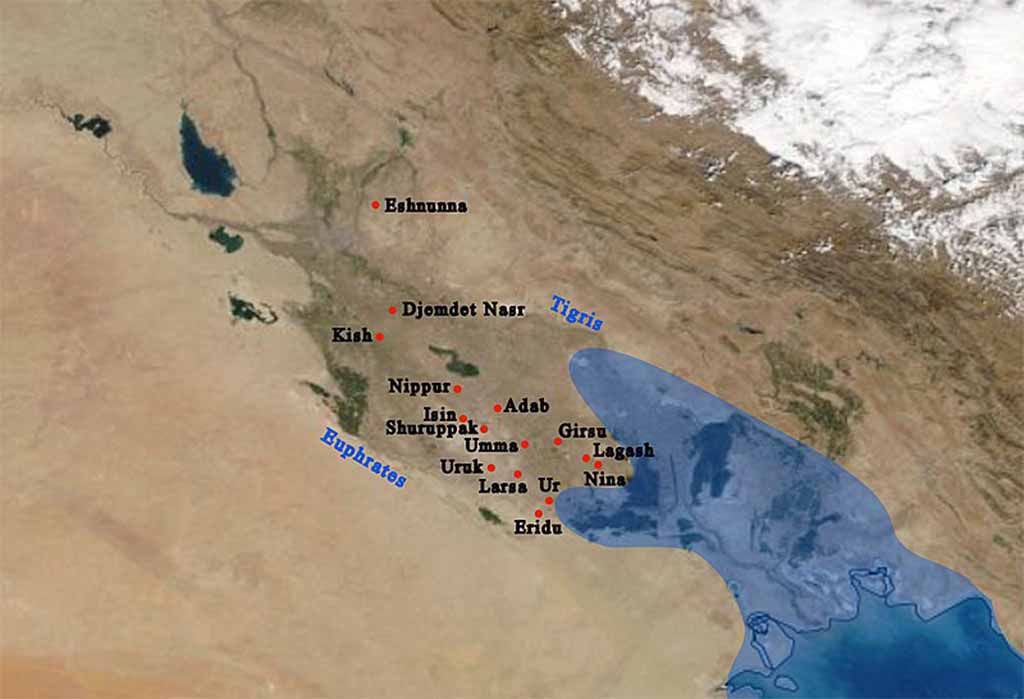
Larsa: Cult City State Basking Under The Sumerian Sun
The fall of the Third Dynasty of Ur at end of the third millennium echoed over the land of Sumer, between the Tigris and Euphrates in ancient southern Mesopotamia and it opened the landscape for the southern rival city states of Isin and Larsa (1924 – 1763 BC) to rise. Larsa, located about 20 kilometers (12 miles) southeast of Uruk, was previously under hegemony of Ur, but after the fall of Ur, during an interim period it had been subjugated to Lagash. When King Ishbi-Erra of Isin conquered Lagash, he appointed governors to rule over Larsa. Over centuries the rivalry between Larsa and Isin would resemble two rams battering heads, until the stronger Bull of Babylon trampled both.

Southern Sumerian city states, with the coast of the Persian Gulf reaching Ur (circa third – second millennium BC) (Public Domain)
In 1932 BC one of these governors, an Amorite named Gungunum, exercised a successful coup d’etat and at last established an independent dynasty in Larsa. His father, Samium is named as a king/ruler of Larsa in a text found at Girsu (the religious centre), which indicates a generational progression of Larsa breaking-away from Isin. Gungunum and his successors further crippled Isin by redirecting the water canals, thus depriving Isin of its life source. Larsa was also situated on the main Persian Gulf trade route, so the city-state rose as the most prominent economic centre in the region, after Ur’s ultimate defeat by the Elamites. Larsa reached its peak under King Rim-Sin I (c. 1758–1699 BC), and by then it controlled 10–15 other city-states. Larsa was finally basking in its place under the Sumerian sun. But the glory of the city state was short lived, for the Babylonians came marching south over the land.

Last King of Larsa Rim-Sin I foundation figurine (1822–1763 BC). Oriental Institute Museum, University of Chicago (CC0)
Scant Sources for Larsa
There is scant evidence of Larsa being mentioned in archaeological finds, before its rise as a strong city state. King Eanatum of Lagash’s Stele of Vultures (circa 2450 BC) mentions that he made the King of Umma swear an oath to Larsa’s sun god Utu, and it refers to sacrifices that were performed at Utu’s temple in Larsa. It is called the Stele of Vultures for it depicts vultures flying away from the battlefield with the heads of the slain enemy in their beaks. Larsa had been occupied since the Ubaid Period (sixth to fourth century BC) and by the time King Eanatum had annexed Larsa, it had been firmly established as a cult centre for the sun god Utu.

A fragment of the Stele of the Vultures of the King Eannatum of Lagash, showing vultures with severed human heads in their beaks and a fragment of cuneiform script. Found in Girsu. (Sting/ CC BY-SA 4.0)
Larsa did not feature prominently during the reign of Sargon the Great of Akkad, (2300 – 2200 BC) nor his descendants either, as it is scarcely mentioned in any of the texts of that era. When Sargon conquered Ur, Uruk, Eninmar, Lagash and Umma, there is no mention of contemporary Larsa, and neither is it mentioned as one of the cities that revolted against Sargon’s grandson Narram-Sin. Isin, however, is recorded that it was definitely occupied during the Sargon period. The collection of temple hymns, composed by Enheduanna, Sargon’s daughter, does refer to the temple of the sun god Utu (known as Shamash to the Akkadians) at Larsa. Clearly it was an important cult centre before and during the Third Dynasty of Ur, but it did not feature as a major city state.




